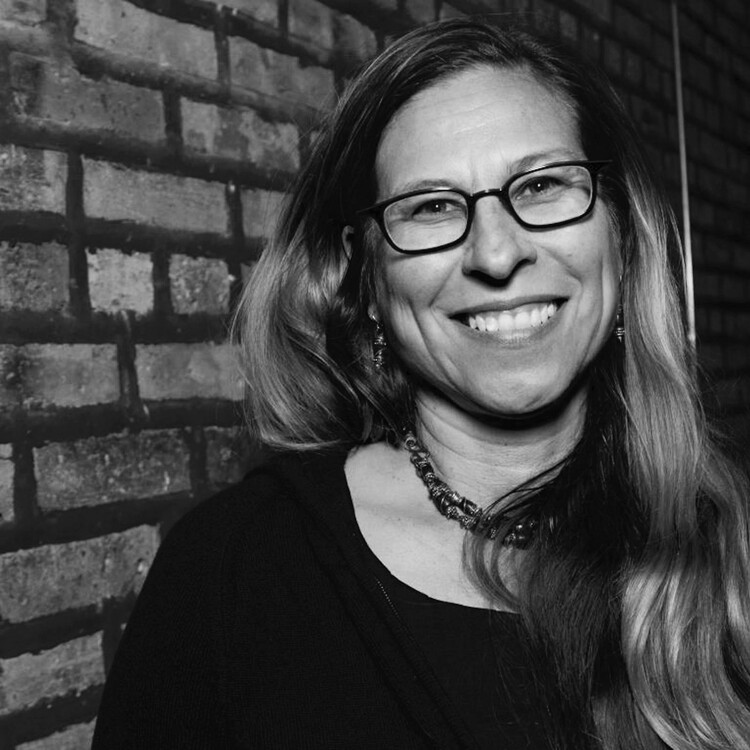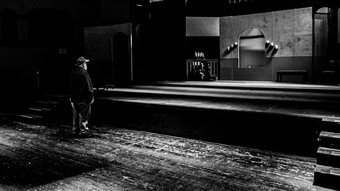Directing Diverse Worlds
An Interview with Tlaloc Rivas
Many years ago, I made a personal commitment to bear witness to the work of other Latina/o playwrights and directors—no matter where they were in the world. I’ve spent a lot of time on the road in order to be in the room, to catch the ethereal quality of their work in my hands.
In this spirit, I attended my colleague Tlaloc Rivas’s university production of Water by the Spoonful in Iowa City in 2013. As a Chicago playwright, I was interested in how one might build bridges to include directors, like Tlaloc, in Latina/o works in Chicago. I was also curious about the parallels between directing in a university space and a regional theater.
Elaine: I thought your production of Quiara Alegría Hudes’s Water by the Spoonful, at the University of Iowa in October of 2013 was a real coup. The triumph of your direction was twofold: emotional and visual. As a playwright witnessing your work, I thought, “Here is a director I would trust anytime.”
Tlaloc: Thanks! That’s really kind of you. Quiara and I are friends and colleagues and it was especially important that I honored that long friendship with my recent production of her play. I worked hard to illuminate the world of the play, while also feeling a freedom that the playwright was able to place confidence in me to explore and interpret every moment.
Elaine: Your production of Water by the Spoonful triumphed with its heart. There was an emotional veracity in the actors that I rarely see. What did you do in rehearsal to get them to wholly commit body, mind, and soul to such emotional honesty?
Tlaloc: One of the reasons I love working at The University of Iowa is because of our students and the faculty mentorship they receive. Our creative teams and ensembles here are willing and able to try and do everything you ask them to.
I believe that my cast loved the play to begin with—and they loved their characters. This is great, but there are red flags to this. Too much love for something or someone can be suffocating, right? It can also happen with an actor’s process. So I told them to, above all, embrace the contradiction of their characters. You have to love the bad as much as the good. I reminded them of that in rehearsal every day.
Elaine: I’ve always been drawn to concomitant worlds on stage and how directors realize those elements of my text. After seeing your production, I was struck by how you skillfully avoided what I considered the traps of the play: long online interactions among characters, two relatively separate storylines/worlds, and their collision. What process did you use to keep the two worlds of the play delineated?
Tlaloc: I tried to get the actors to understand how the “scoring” and the rhythm of the play worked. We spent an entire week at the table, which is oddly the exception not the rule these days, and that got the actors a little antsy. But only when you get the ensemble to buy into your vision of the dramatic action will you be able to avoid the “traps” that you mentioned.
There were elements from my toolbox of acting and directorial techniques that I used, but I also stole a trick from Athol Fugard in which you keep the actors on stage at least six feet apart from each other at all times until there is a moment of reversal or great intensity. I also inserted, without the ensemble’s knowledge, elements from Elliot, the first of Quiara’s three-part play series, into the staging—no dialogue, but fugue-like movements that informed transitions and moments of solitude.
The opportunity to utilize multimedia allowed me, as director, the unique opportunity to emphasize the social and cultural aspects of the play. Social in that the family communications exist not just in letters and phone calls—they are defined by texts, Skyping, Vines, and Instagrams. And because most Latina/os place family above all else, relationships, as written by Quiara, are subtly brilliant. There are times when she uses instant chat and text message to castigate, alienate, or offer forgiveness between one character and another. The ability to articulate this particular aspect of the story using the technology and multimedia design at our disposal made a huge difference.
Elaine: Now that I’m going to be an Assistant Professor at the University of Arizona, I’m thinking more about how university spaces translate to professional spaces. At the University of Iowa, The David Thayer Theatre seats approximately 200 and is a flexible black box with a soaring height. Tell me more about working in that space.
Tlaloc: It’s really one of the best spaces to work in. You can light from any position and nearly from any angle. I love to create “layering” in my productions i.e., simultaneous action on different planes (upstage to downstage) and sculpting actors onstage in their “worlds” as transitions or scenes continue. Lighting helps define those planes for me.
Elaine: Playwrights write with limitless possibility and muse on how those elements might be executed. What kind of directions did you give the designers?
Tlaloc: Finding the right collaborator is key. I know where my weaknesses are and I try to find the right designers to help translate and expand my ideas and concepts for the elements of the play. I use a notebook to articulate ideas and inspirations and also to list challenges and fears.
As a Chicano director and writer, I am inspired by my own culture—the influence of poetry and magical realism, the contradictions and collision of European and Indigenous cultures, the corridos and huapangos of home, the memories of sitting on the porch hearing my family’s stories, and my own ever-growing inquiry into the nature of storytelling—from the specific to the universal—all came to mind in the design of the play.
I really benefited from working with Korean-born set designer Taesup Lee. Taesup created a soaring mountain of chairs, which became the El Yunque forest but also reflected the symbolic weight of recovery from drug addiction. The set looked like a giant “chutes and ladders” landscape and it also represented the treacherous dangers and temptations of relapsing into addiction.
Elaine: As someone who is in the middle of working on two trilogies, I’ve tracked with great interest how Quiara has managed hers. I’ve wondered about directors for these pieces and how those directors might or might not consider the other pieces as they attack a single work. In this case, Water by the Spoonful is the second installment of Quiara Alegría Hude’s Elliot Trilogy. Did the other plays of the trilogy, Elliot, a Soldier’s Fugue, and The Happiest Song Plays Last, feed into your process or did you find it necessary to focus on Water by the Spoonful as a stand-alone piece?
Tlaloc: I had read and seen Elliot, but not Happiest Song and I purposefully chose not to look ahead in the story. Aesthetically, I chose to conceptually approach Spoonful as a stand-alone play. The actors who played Elliot, Yazmin, and Odessa all read Elliot to gain a better understanding of the backstory of the Ortiz family. Both the actor playing Elliot and I come from families who served and continue to serve in the military, so we had personal experience which illuminated our process with the play. I also lived in Philadelphia, where the play takes place, so I knew every reference to the city. My directing mentor, José Carrasquíllo, provided me specific dramaturgical details about Puerto Rico and the questions of identity facing its population in America.
Elaine: I’ve often been at the first reading of one of my plays and heard the director warn the actors not to get lost in the poetic language or musicality of the play. Do you find Quiara’s work a directing challenge for this reason? What are these challenges from your point of view and what advice would you give to directors taking on her work for the first time?
Tlaloc: Every new play is a challenge, and it is imperative to immerse yourself in the cultural and sociopolitical world of the play in order to have accurate authenticity. Quiara’s background is unique in that she studied music composition before turning to playwriting. As a director, I’m very much informed by rhythm and movement on stage, so I feel particularly adept in directing work like Quiara’s; but I’m not a musician, so there was a bit of a learning curve to understand how Coltrane’s music influenced the “scoring” of the play. Once the ensemble and I figured out how to “play” certain scenes like a musician would “play” a piece of music, it was electrifying. In a way, I learned a lot just by directing Quiara’s play, from the phrasing and structure of the scenes to her intricate use and references to time used in the play.
Elaine: Many of us work in both the professional theater and in university settings. As an artist who straddles the worlds of both, what dreams do you have for the two to better feed each other?
Tlaloc: I believe that one feeds the other and vice versa. There is a high level of production and design support at U of I, which has pushed me as a director in collaboration with designers. Because of this, I feel completely ready to make effective use of design and production elements—and efficient use of the budgets that support them—in my professional work.
I believe that professional theater and academic theater feed each other by the flow of young artists entering the profession after training, and by the steady exchange of experienced professionals. Nothing meant more to me as a student than the professional experience of my professors. Also, the rigorous questioning I engage in as a teacher makes me a finer director, and connecting with my students keeps me powerfully grounded in the essential elements of the art form.
Elaine: Where will we be able to see your work next?
Tlaloc: I’m really excited to share my production of Mariela in the Desert by Karen Zacarías at the Los Angeles Theatre Center this fall. The production is one of ten pieces selected for presentation at the Latina/o Theatre Commons National Encuentro in October. I hope that artistic directors, producers, and theater artists from all points on the spectrum of diversity in our country will come and see the work in LA. It’s going to be great!












Comments
The article is just the start of the conversation—we want to know what you think about this subject, too! HowlRound is a space for knowledge-sharing, and we welcome spirited, thoughtful, and on-topic dialogue. Find our full comments policy here
Great to hear from both of you in such detail! Thanks for sharing your process, Tlaloc. I love Quiara's work and am happy it was in your hands-- and that the students were able to soak in it.